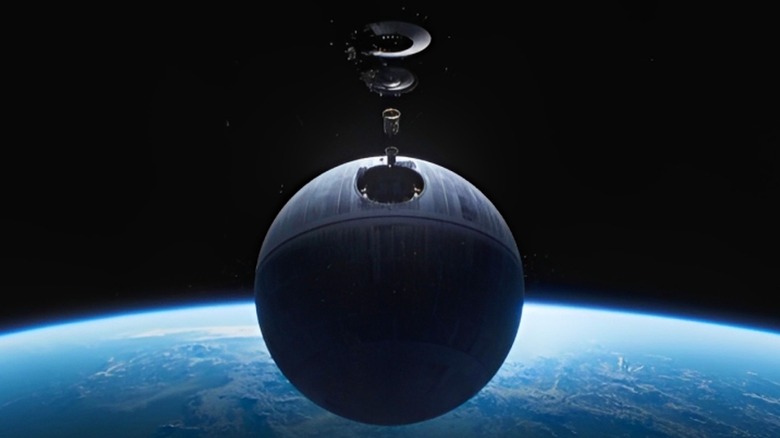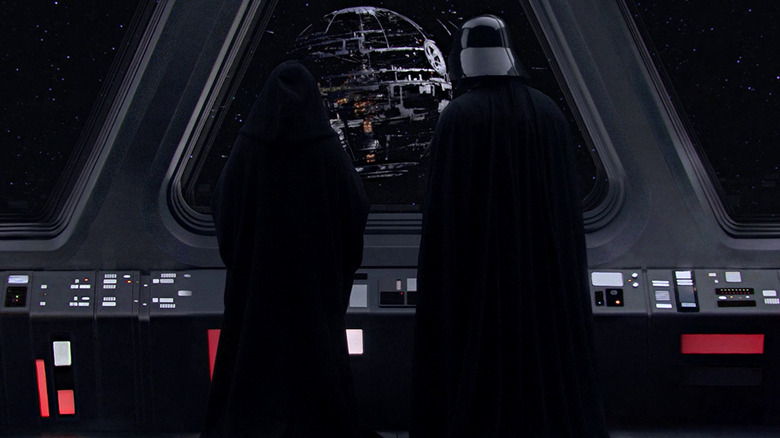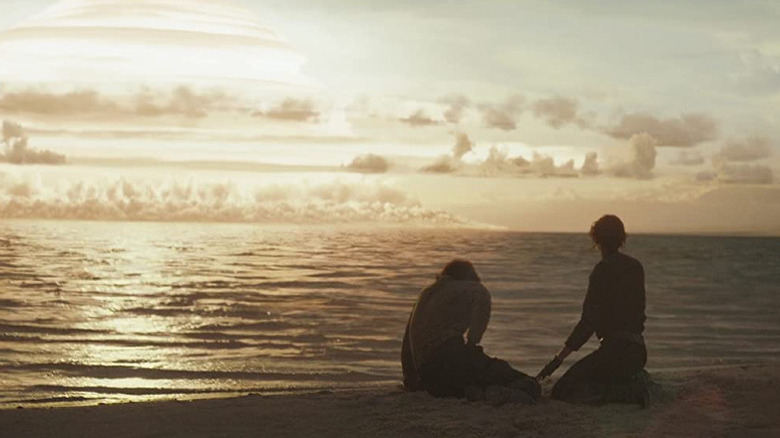Star Wars: How Much It Would Cost To Build And Operate The Death Star
The majority of the political ramifications that occur within the "Star Wars" universe during the Rise of the Empire era are based on the development, construction, operation, and destruction of the original Death Star. First introduced to audiences in 1977 in "Star Wars: A New Hope" (and chronologically through its schematics in "Star Wars: Attack of the Clones"), this space station and superweapon was the physical embodiment of the Empire's supremacy over the galaxy.
Naturally, the construction and operations of the Death Star would cost, well, an astronomical amount of money. As Dr. John Hammond (Richard Attenborough) from "Jurassic Park" would say, the Empire "spared no expense" regarding the superweapon that destroyed the planet Alderaan. But what would the actual budget for the space station be, vis-à-vis the Imperial credit-to-U.S. dollar conversion?
The ability to gather all of Earth's money is insignificant next to the budget of the Death Star
According to a 2012 study featured in the Lehigh University students' economics blog Centives, the construction budget of the original Death Star is a whopping $852,000,000,000,000,000. To readers having trouble verbalizing this astronomical number, that is the equivalent of $852 quadrillion in Imperial credits from building it alone, dwarfing the 2012 global GDP by 13,000 times. When you apply this number to the U.S. Inflation Calculator from 2012 to 2025, based on a cumulative rate of inflation of 39%, the construction budget today would be in the ballpark of $1,184,080,873,193,550,300, or $1.2 quintillion. The study further explains that the expenses are due to the steel production, which is estimated to take 833,315 years. By scaling the Death Star, this calls for around 1.08 x 1,000,000,000,000,000 tonnes of steel. The study also claims that Earth has enough iron material to create 2 million Death Stars.
The statistics mentioned above is all from the construction alone, but what about powering the Death Star? According to a 2016 infographic that the British energy supplier Ovo Energy created (via CNET), the daily operation costs would be around $7,700,000,000,000,000,000,000,000,000 or $7.7 octillion. Just from that sheer number alone, it's safe to assume that the budget applied to today's inflation trends would be more annoying to calculate than spending an entire day with Jar Jar Binks.
Thanks to Galen Erso, Rogue One, and Luke Skywalker, the original Death Star is all but Galactic history
For years, one of the most notable plot holes in "Star Wars: A New Hope" was the fact that the Death Star featured a critical vulnerability, making it easier for Luke Skywalker (Mark Hamill) to destroy the space station in the original film's climactic battle. The idea that the Empire would intentionally build such a weakness within their superweapon is admittedly a patently stupid decision, and had been the source of ridicule from critics and fans alike for nearly 40 years. But the 2016 release of "Rogue One" changed that perception when that film revealed that Imperial research scientist Galen Erso (Mads Mikkelsen), the prime designer of the Death Star, harbored Oppenheimer-esque guilt over its creation — so much so, that he secretly put in a vulnerability within it, which is featured in the Death Star plans that the titular squad retrieve in their fatal mission on the planet Scarif. To think, all of that money the Empire would burn in the creation and operations of the Death Star, only to be destroyed thanks to its prime designer's proverbial middle finger to the regime. Fans can read more about Galen Erso's backstory in the book, "Catalyst: A Rogue One Novel."
The Empire would eventually attempt to construct a second Death Star in "Star Wars: Return of the Jedi," only to be destroyed by the Rebel Alliance led by Lando Calrissian (Billy Dee Williams). Nearly 30 years later, the First Order would construct Starkiller Base in "Star Wars: The Force Awakens," which would be destroyed by a fleet of Resistance X-Wing pilots led by Poe Dameron (Oscar Isaac). The iconography of the Death Star within the franchise's canon cannot be denied, but here's hoping that Lucasfilm will never bring back a similar space station and superweapon in another film ever again. Once was enough, two was pushing it, but three times signifies a lack of imagination. But then again, "Star Wars" is also a franchise that explores the idea of history repeating itself, so who knows what the future holds.
The rise of the first Death Star will be prominently featured in "Andor" season 2, which will premiere its first three episodes on Disney+ on April 22, 2025.


